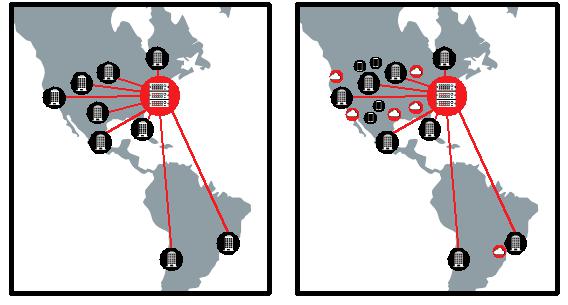This article was originally published on SDxCentral.com on November 27, 2017.
Recently announced partnerships between Google and hyperconverged infrastructure (HCI) vendors, such as Cisco and Nutanix, shed light on the evolution of hybrid cloud architectures. Closer integration between big names in cloud and HCI, such as Amazon Web Services (AWS)and IBM partnering with VMware/Dell EMC, will help enterprises enable their hybrid cloud strategies by making it easier to manage workloads across different environments. Still, the agility promised by these partnerships will be hampered without a rethink of network architecture and the use of software-defined wide-area networking (SD-WAN).
To begin, it is important to understand what HCI is addressing. HCI is a software-defined approach to the integration of compute, storage, and networking with virtualization technology that is intended to simplify the deployment and management of resources. The net gains come in the form of better business agility; centralized management of HCI resources makes it easier to move workloads to available resources. Also, use of a standardized platform allows enterprise IT departments to easily add nodes to the hyperconverged infrastructure, thus expanding capacity.
However, there is a limit to how much HCI capacity can fit into an enterprise data center. That’s where the Google and Nutanix example comes into play — giving customers a single control plane to deploy and migrate applications in/to either cloud environment. These partnerships show that enterprises still need compute capacity off premises, whether it is for sending workloads to clouds that can run applications more efficiently, or for mitigating the risk associated with being in a limited number of locations.
Hybrid Cloud Strategies Held Back by the Network
While a hybrid HCI and public cloud strategy can address a number of issues for enterprises, network performance isn’t necessarily one of them. Connecting assets together is a critical — and often overlooked — aspect of hybrid cloud strategies. A look at a typical enterprise network shows why.
A typical enterprise, as seen in the figure below, has provisioned MPLS services between branch offices and headquarters. Traffic to and from the Internet, cloud providers, and Software-as-a-Service (SaaS) providers goes through connections at the headquarters’ data center.

Figure A: Diagram of remote/branch, to enterprise, to cloud.
The right side of the diagram illustrates how enterprise users are actually accessing applications, including third-party SaaS applications. These are located in a variety of data centers around the globe, and users are frequently accessing them from mobile devices on wireless networks, which adds another issue for application performance. These simple scenarios reveal that the enterprise data center is a sub-optimal interface for network traffic for the following reasons:
There is added latency because packets are being ‘hair-pinned’ through the enterprise data center.
After exiting the WAN, traffic to cloud-based applications traverses the public Internet, which is an additional source of application performance and security issues.
Enterprises can try to address WAN and cloud performance issues with the use of direct, private connections. This entails buying links from a network service provider that has already connected with the cloud provider at a multi-tenant data center.
Both Microsoft and Google have options that allow for traffic to traverse their respective private networks, and egress the network in different regions. This is important because enterprises are being offered more options for moving data around once on the communication service providers’ (CSP) platform, and can balance price and performance trade-offs according to application needs.
Networks are the Weak Link Between HCI, Cloud
The connection between the HCI in the enterprise data center and in the facility that the CSPs’ equipment is located in is still the weak link. The reality is that enterprises are already running applications in a mix of public and private clouds, and when including the use of SaaS applications, the number of cloud vendors being used by enterprises is often between four to eight vendors, according to data from industry research firms.
In these circumstances, using direct interconnection with each cloud vendor doesn’t scale well from a cost or operational perspective. Typical WAN topologies and architectures are rigid and static – adding new MPLS links can take weeks or months — taking away much of the flexibility offered by the use of HCI. For those companies, other approaches to network architecture should to be considered.
A distributed WAN architecture is one such approach. Enabled by SD-WAN technology, traffic from regional branches of the enterprise, or partners and suppliers, can be aggregated into regional hubs. These hubs are located in carrier neutral multi-tenant data centers, using SD-WAN to bind the hubs together.
SD-WAN allows for easier configuration and adjustment of routes and application-level optimization, but aggregating network traffic into hubs also allows for the strategic placement of HCI infrastructure at this mid-tier of the hybrid IT stack. Services such as WAN acceleration/optimization and security can be incorporated, and the hubs can be optimized for different functions, such as data processing and storage or enhanced application performance.
Partnerships between HCI vendors and CSPs are providing the prospect of better manageability for hybrid cloud environments. The network that connects them together needs to follow suit. While direct interconnection services are a step in the right direction, a distributed network architecture built around SD-WAN provides a better alternative that addresses performance and security concerns in a way that’s manageable for the enterprise.

